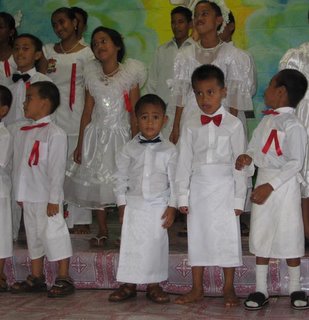
The palolo worm is a segmented marine coral worm (within the polychaete class for you marine biology nerds), related to the earthworm. It's apparently found across most, if not all, of the South Pacific islands, living about three or four metres underwater, occupying the crevices of coral reefs. The worms are usually five to eight centimetres long and are pink-brown or blue-green coloured.
In both October and November, typically on the day before and the day of the last quarter moon, the palolo spawn. Each worm crawls backward out of its hole. The back part of its body breaks off and wriggles to the surface of the sea, then the front end returns to the burrow to
grow a new hind part. Meanwhile, at the water's surface, the brownish males and blue-green females discharge their sperm and eggs, respectively, beginning a new generation of palolo worms. In short, it's a massive worm orgy.
For Samoans, the palolo is considered quite the delicacy. Thousands of people flock to beaches across the Samoan islands in the early hours of the morning to catch as much of it as they possibly can. On Sunday night/Monday morning, armed with nets, sieves, buckets and torches, a handful of Australians joined the hunt.
We left home at midnight and drove for an hour or so to Salamumu, a beach on the southern side of the island, where we spent a few hours lying on the beach looking up at the stars (wow!) and checking for signs of the palolo. At roughly 4am, the palolo was spotted and we joined a couple of hundred people (at our beach) in the water to catch the worms. When we started it was still pitch black, but the flickering of torches in the water could be seen for kilometres down the coast. It was an incredible thing to see. I can't begin to put it into words.
With the aid of our torches, we spotted (and netted) countless blue-green and brown worms, squirming around just under the surface of the water. They were everywhere! We had a lot of fun, but for many of the Samoans nearby it was a serious task. Once they rise, there is not a lot of time to catch the palolo, as they disintegrate in the morning sun. Every minute counts. We continued until about 5.30am when the sun started to rise. Several people nearby were very curious to see how many palolo the palagis had managed to catch. I don't think we did too badly; we certainly had enough for all of us to try.
Palolo is traditionally eaten alive, fried in butter or baked in breadfruit leaves in an umu. Not having an umu handy, the best we could do was fry it in butter. I ate a few live ones, but I suspect I'd have to eat a small handful to really get a sense of the "raw" taste. We chose to cook the palolo in butter and spread it on toast (kind of like pate). Within seconds of the worms hitting the heated pan, they turned into a blue-green mush. Certainly not the most attractive sight you've seen. Spread across toast it didn't look that much better (as shown in the image).
It didn't taste too bad, but then again, to our uneducated palettes, it didn't taste too much of anything. Maybe I stuffed up in the cooking. Yesterday at work I managed to have some palolo that had been baked in an umu. It tasted great, most similar to the taste of mussels. It made me begin to see why the Samoans consider it such a delicacy.


